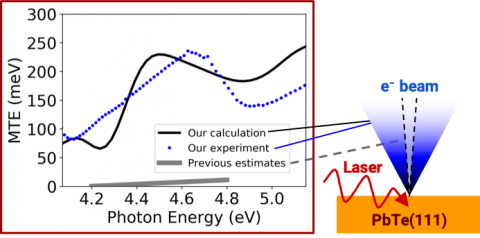Electron-Phonon Scattering Effects on Mean Transverse Energy in PbTe(111) Photocathodes
J. K. Nangoi, T. A. Arias, S. S. Karkare, H. A. Padmore, and W. A. Schroeder
At room temperature, scattering between electrons and phonons (crystal vibrations) significantly affects the mean transverse energy (MTE) of the electron beam coming out from a PbTe(111) photocathode. We show this by calculating the MTE from first principles, which has far better agreement with our experimental data than previous theoretical estimates. Our results show that the MTE is large, hundreds of meV, which means the electron beam is not as highly focused as it was initially predicted. Hence, at room temperature PbTe(111) is not a good material for next-generation high brightness photocathodes, which require highly focused beam with very low MTE ≤ 10 meV. Our work gives deeper understanding into photoemission, and will help us search for better photocathode materials for next-generation particle accelerators, microscopes, and other devices that require high brightness.
Full article:
Proceedings of the 9th Int. Particle Accelerator Conf., IPAC 2018, Vancouver, BC, Canada, 2018, https://doi.org/10.18429/JACoW-IPAC2018-TUPMF065.

